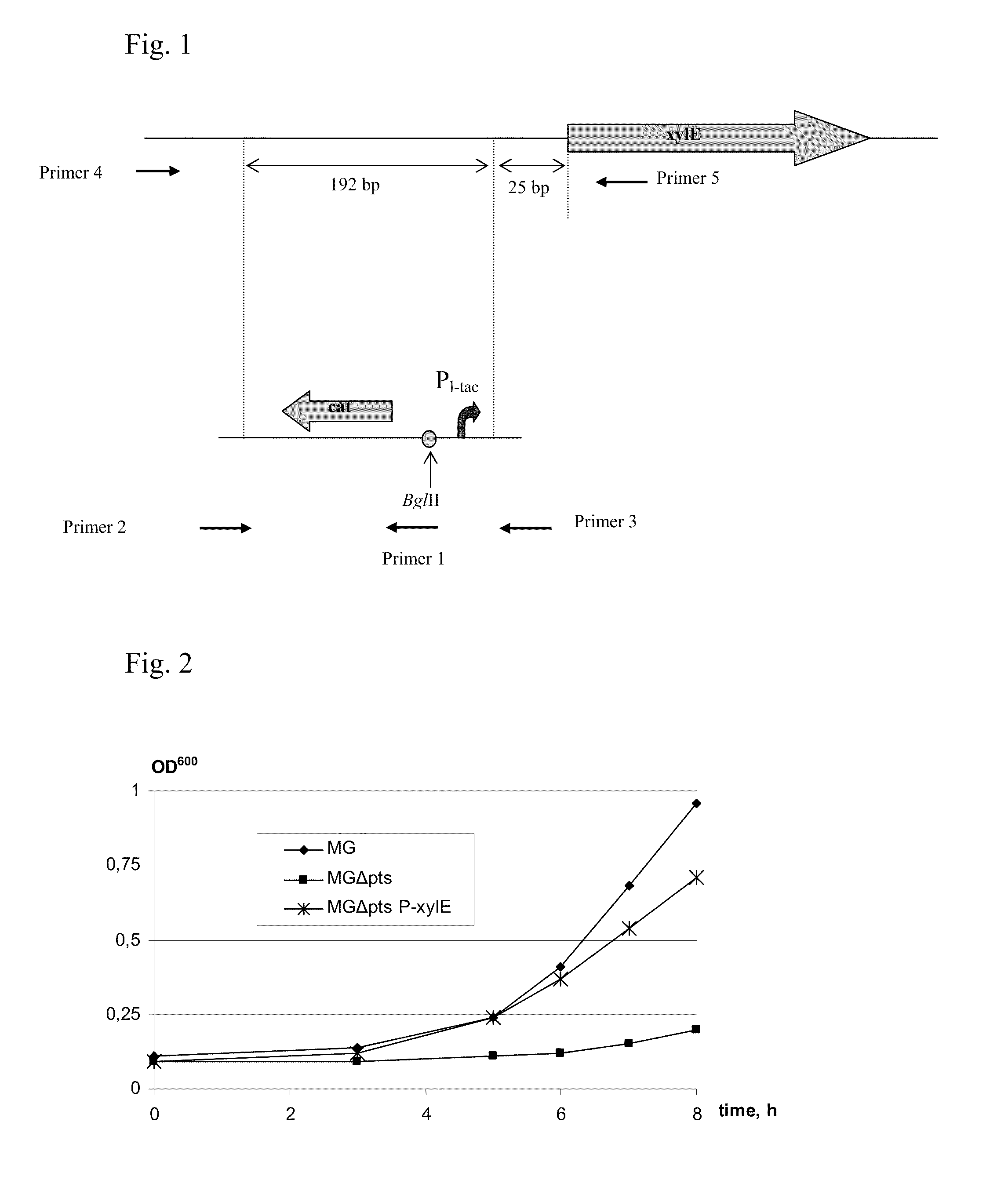Method for producing l-amino acids using bacteria of the enterobacteriaceae family
a technology of enterobacteriaceae and l-amino acids, which is applied in the field of fermentation and lamino acid production, can solve the problems of insufficient carbon source access in highly productive strains, no report to date of using a bacterium of the enterobacteriaceae family, etc., and achieve the effect of enhancing the productivity of l-amino acid-producing strains
- Summary
- Abstract
- Description
- Claims
- Application Information
AI Technical Summary
Benefits of technology
Problems solved by technology
Method used
Image
Examples
example 1
Substitution of the Native Promoter Region of the xylE Gene in E. coli by Hybrid PL-tac Promoter
[0128]To substitute the native promoter region of the xylE gene, a DNA fragment carrying a hybrid PL-tac promoter and chloramphenicol resistance marker (CmR) encoded by the cat gene was integrated into the chromosome of the E. coli MG1655 (ATCC 700926) in place of the native promoter region by the method described by Datsenko K. A. and Wanner B. L. (Proc. Natl. Acad. Sci. USA, 2000, 97, 6640-6645) which is also called as a “Red-mediated integration” and / or “Red-driven integration”. The recombinant plasmid pKD46 (Datsenko, K. A., Wanner, B. L., Proc. Natl. Acad. Sci. USA, 2000, 97, 6640-6645) having a thermosensitive replicon was used as the donor of the phage λ-derived genes responsible for the Red-mediated recombination system. Escherichia coli strain BW25113 containing the recombinant plasmid pKD46 can be obtained from the E. coli Genetic Stock Center, Yale University, New Haven, USA, t...
example 2
Effect of Increasing the xylE Gene Expression on Growth of an E. coli Strain Having a Disrupted PTS Transport System
[0135]To show the effect of enhanced expression of the xylE gene on growth of an E. coli strain, the E. coli strain having a disrupted PTS transport system was constructed.
[0136]For that purpose, the DNA fragment carrying kanamycin resistance marker (KmR) was integrated into the chromosome of the E. coli MG1655 / pKD46 in place of the ptsHI-crr operon by the method described by Datsenko K. A. and Wanner B. L. (Proc. Natl. Acad. Sci. USA, 2000, 97, 6640-6645) which is also called as a “Red-mediated integration” and / or “Red-driven integration”, also described in Example 1.
[0137]The ptsHI-crr operon has been elucidated (nucleotide numbers 2531786 to 2532043, 2532088 to 2533815 and 2533856 to 2534365 for ptsH, ptsI and crr genes, respectively, in the sequence of GenBank accession NC—000913.2, gi: 49175990). The ptsHI-crr operon is located between cysK and pdxK genes on the c...
example 3
Effect of Increasing the xylE Gene Expression on Threonine Production
[0144]To test the effect of enhanced expression of the xylE gene which is under the control of PL-tac promoter on threonine production, DNA fragments from the chromosome of the above-described E. coli MG1655PL-tacxylE were transferred to the threonine-producing E. coli strain VKPM B-3996 by P1 transduction (Miller, J. H. (1972) Experiments in Molecular Genetics, Cold Spring Harbor Lab. Press, Plainview, N.Y.). The strain VKPM B-3996 was deposited in Russian National Collection of Industrial Microorganisms (VKPM) (Russia, 117545 Moscow, 1st Dorozhny proezd, 1) on Apr. 7, 1987 under the accession number B-3996.
[0145]Both E. coli strains B-3996 and B-3996PL-tacxylE were grown for 18-24 hours at 37° C. on L-agar plates. To obtain a seed culture, the was grown on a rotary shaker (250 rpm) at 32° C. for 18 hours in 20×200 mm test tubes containing 2 ml of L-broth with 4% sucrose. Then, the fermentation medium was inoculat...
PUM
 Login to View More
Login to View More Abstract
Description
Claims
Application Information
 Login to View More
Login to View More - R&D
- Intellectual Property
- Life Sciences
- Materials
- Tech Scout
- Unparalleled Data Quality
- Higher Quality Content
- 60% Fewer Hallucinations
Browse by: Latest US Patents, China's latest patents, Technical Efficacy Thesaurus, Application Domain, Technology Topic, Popular Technical Reports.
© 2025 PatSnap. All rights reserved.Legal|Privacy policy|Modern Slavery Act Transparency Statement|Sitemap|About US| Contact US: help@patsnap.com

